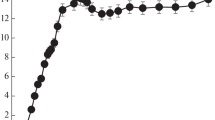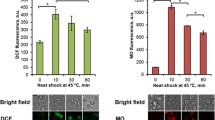Abstract
Yeasts capable of growing and surviving at high temperatures are regarded as thermotolerant. For appropriate functioning of cellular processes and cell survival, the maintenance of an optimal redox state is critical of reducing and oxidizing species. We studied mitochondrial functions of the thermotolerant Kluyveromyces marxianus SLP1 and the mesophilic OFF1 yeasts, through the evaluation of its mitochondrial membrane potential (ΔΨm), ATPase activity, electron transport chain (ETC) activities, alternative oxidase activity, lipid peroxidation. Mitochondrial membrane potential and the cytoplasmic free Ca2+ ions (Ca2+ cyt) increased in the SLP1 yeast when exposed to high temperature, compared with the mesophilic yeast OFF1. ATPase activity in the mesophilic yeast diminished 80% when exposed to 40° while the thermotolerant SLP1 showed no change, despite an increase in the mitochondrial lipid peroxidation. The SLP1 thermotolerant yeast exposed to high temperature showed a diminution of 33% of the oxygen consumption in state 4. The uncoupled state 3 of oxygen consumption did not change in the mesophilic yeast when it had an increase of temperature, whereas in the thermotolerant SLP1 yeast resulted in an increase of 2.5 times when yeast were grown at 30o, while a decrease of 51% was observed when it was exposed to high temperature. The activities of the ETC complexes were diminished in the SLP1 when exposed to high temperature, but also it was distinguished an alternative oxidase activity. Our results suggest that the mitochondria state, particularly ETC state, is an important characteristic of the thermotolerance of the SLP1 yeast strain.






Similar content being viewed by others
References
Aguilar-Toral R, Fernández-Quintero M, Ortiz-Avila O, Hernández de la Paz L, Calderón-Cortés E, Rodríguez-Orozco AR, Saavedra-Molina A, Calderón-Torres M, Cortés-Rojo C (2014) Characterization of the effects of a polyunsaturated fatty acid (PUFA) on mitochondrial bioenergetics of chronologically aged yeast. J Bioenerg Biomembr 46:205–220
Avéret N, Fitton V, Bunoust O, Rigoulet M, Guérin B (1998) Yeast mitochondrial metabolism: from in vitro to in situ quantitative study. Mol Cell Biochem 184(1–2):67–79
Balogh G, Horváth I, Nagy E, Hoyk Z, Benkö S, Bensaude O, Vígh L (2005) The hyperfluidization of mammalian cell membranes acts as a signal to initiate the heat shock protein response. FEBS J 272:6077–6086
Bonnet S, Archer SL, Allalunis-Turner J, Haromy A, Beaulieu C, Thompson R, Lee CT, Lopaschuk GD, Puttagunta L, Bonnet S, Harry G, Hashimoto K, Porter CJ, Andrade MA, Thebaud B, Michelakis ED (2007) A mitochondria-K+ channel axis is suppressed in cancer and its normalization promotes apoptosis and inhibits cancer growth. Cancer Cell 11:37–51
Buege JA, Aust SD (1978) Microsomal lipid peroxidation. Methods Enzymol 52:302–310
Burhans WC, Heintz NH (2009) The cell cycle is a redox cycle: linking phase-specific targets to cell fate. Free Radic Biol Med 47:1282–1293
Cao J, Barbosa JM, Singh NK, Locy RD (2013) GABA shunt mediates thermotolerance in Saccharomyces cerevisiae by reducing reactive oxygen production. Yeast 30:129–144
Caspeta L, Castillo T, Nielsen J (2015) Modifying yeast tolerance to inhibitory conditions of ethanol production processes. Front Bioeng Biotechnol 3:184
Caspeta L, Chen Y, Ghiaci P, Feizi A, Buskov S, Hallström BM, Petranovic D, Nielsen J (2014) Biofuels. Altered sterol composition renders yeast thermotolerant Science 346:75–78
Chou M, Chen YM, Lin CY (1989) Thermotolerance of isolated mitochondria associated with heat shock proteins. Plant Physiol 89:617–621
Cortés-Rojo C, Calderón-Cortés E, Clemente-Guerrero M, Estrada Villagómez M, Manzo-Avalos S, Mejía-Zepeda R, Boldogh I, Saavedra-Molina A (2009) Elucidation of the effects of lipoperoxidation on the mitochondrial electron transport chain using yeast mitochondria with manipulated fatty acid content. J Bioenerg Biomembr 41(1):15–28
Cross JL, Meloni BP, Bakker AJ, Lee S, Knuckey NW (2010) Modes of neuronal calcium entry and homeostasis following cerebral ischemia. Stroke Res Treat 2010:316862
Dani C, Bonatto D, Salvador M, Pereira MD, Henriques JA, Eleutherio E (2008) Antioxidant protection of resveratrol and catechin in Saccharomyces cerevisiae. J Agric Food Chem 56:4268–4272
Davidson JF, Schiestl RH (2001) Mitochondrial respiratory electron carriers are involved in oxidative stress during heat stress in Saccharomyces cerevisiae. Mol Cell Biol 21:8483–8489
Fedoseeva IV, Pjatricas DV, Varakina NN, Rusaleva TM, Stepanov AV, Rikhvanov EG, Borovskii GB, Voinikov VK (2012) Effect of amiodarone on thermotolerance and Hsp104p synthesis in the yeast Saccharomyces cerevisiae. Biochemistry (Mosc) 77(1):78–86
Fiske CH, Subbarow Y (1925) The colorimetric determination of phosphorus. J Biol Chem 66(2):375–400
Flores JA, Gschaedler A, Amaya-Delgado L, Herrera-López EJ, Arellano M, Arrizon J (2013) Simultaneous saccharification and fermentation of Agave tequilana fructans by Kluyveromyces marxianus yeasts for bioethanol and tequila production. Bioresour Technol 146:267–273
Gschaedler A, Ramírez J, Díaz D, Herrera E, Arrizón J, Pinal L, Arellano M (2004) Fermentación. En: Ciencia y Tecnología del Tequila Avances y Perspectivas. CIATEJ, Guadalajara, 61–120
Guérin B, Labbe P, Somlo M (1979) Preparation of yeast mitochondria (Saccharomyces cerevisiae) with good P/O and respiratory control ratios. Methods Enzymol 55:149–159
Hallberg EM, Shu Y, Hallberg RL (1993) Loss of mitochondrial hsp60 function: non equivalent effects on matrix-targeted and intermembrane-targeted proteins. Mol Cell Biol 13(5):3050–3057
Janssen-Heininger YM, Mossman BT, Heintz NH, Forman HJ, Kalyanaraman B (2008) Redox-based regulation of signal transduction: principles, pitfalls, and promises. Free Radic Biol Med 45:1–17
Kim IS, Moon HY, Yun HS, ** I (2006) Heat shock causes oxidative stress and induces a variety of cell rescue proteins in Saccharomyces cerevisiae KNU5377. J Microbiol 44(5):492–501
Kim IS, Kim YS, Kim H, ** I, Yoon HS (2013) Saccharomyces cerevisiae KNU5377 stress response during high-temperature ethanol fermentation. Mol Cell 35:210–218
Kitano H, Sekito T, Ishitomi H, Toshida K (1995) The distribution of ND genes in yeast mitochondrial geomes and the mitochondrial DNA structure of Pichia membrabaefacens. Nucleic Acids Symp Ser 34:23–24
Kominsky DJ, Brownson MP, Updike DL, Thorsness PE (2002) Genetic and biochemical basis for viability of yeast lacking mitochondrial genomes. Genetics 162:1595–1604
Kwong JQ, Molkentin JD (2015) Physiological and pathological roles of the mitochondrial permeability transition pore in the heart. Cell Metab 21(2):206–214
Lee JH, Yun HS, Kwon C (2012) Molecular communications between plant heat shock responses and disease resistance. Mol Cells 34:109–116
Lefebvre-Legendre L, Balguerie A, Duvezin-Caubet S, Giraud MF, Slonimski PP, di Rago JP (2003) F1-catalysed ATP hydrolysis is required for mitochondrial biogenesis in Saccharomyces cerevisiae growing under conditions where it cannot respire. Mol Microbiol 47:1329–1339
Lehninger AL, Carafoli E, Rossi CS (1967) Energy-linked ion movements in mitochondrial systems. Adv Enzymol Relat Areas Mol Biol 29:259–320
Matsuno-Yagi A, Hatefi Y (1996) Ubiquinol-cytochrome c oxidoreductase. The redox reactions of the bis-heme cytochrome b in ubiquinone-sufficient and ubiquinone-deficient systems. J Biol Chem 271(11):6164–6171
Mejía-Barajas JA, Montoya-Pérez R, Salgado-Garciglia R, Aguilera-Aguirre L, Cortés-Rojo C, Mejía-Zepeda R, Arellano-Plaza M, Saavedra-Molina A (2016) Oxidative stress and antioxidant response evaluation in the selection of a thermotolerant yeast. J Braz Microbiol. doi:10.1016/j.bjm.2016.11.005
Muller EG (1995) A redox-dependent function of thioredoxin is necessary to sustain a rapid rate of DNA synthesis in yeast. Arch Biochem Biophys 318:356–361
Parsell DA, Lindquist S (1993) The function of heat shock proteins in stress tolerance: degradation and reactivation of damaged proteins. Annu Rev Genet 27:437–496
Peña A, Sánchez NS, Calahorra M (2010) Estimation of the electric plasma membrane potential difference in yeast with fluorescent dyes: comparative study of methods. J Bioenerg Biomembr 42(5):419–432
Piper PW (1993) Molecular events associated with acquisition of heat tolerance by the yeast Saccharomyces cerevisiae. FEMS Microbiol Rev 11:339–355
Rikhvanov EG, Varakina NN, Rusaleva TM, Rachenko EI, Kiseleva VA, Voinikov VK (2001) Heat shock-induced changes in the respiration of the yeast Saccharomyces cerevisiae. Mikrobiologiia 70:531–535
Rikhvanov EG, Varakina NN, Rusaleva TM, Rachenko EI, Voinikov VK (2002) Sodium Azide reduces the thermotolerance of Respiratively grown yeasts. Curr Microbiol 45:394–399
Rikhvanov EG, Lukina EA, Varakina NN, Rusaleva TM, Gamburg KZ, Knorre DA, Borovskii GB, Voinikov VK (2006) Mitochondria as a critical element of heat shock response in yeasts with different types of energy metabolism. Russ J Plant Physiol 53:615–621
Saidi Y, Finka A, Goloubinoff P (2011) Heat perception and signalling in plants: a tortuous path to thermotolerance. New Phytol 190(3):556–565
Salvado Z, Arroyo-Lopez FN, Guillamon JM, Salazar G, Querol A, Barrio E (2011) Temperature adaptation markedly determines evolution within the genus Saccharomyces. Appl Environ Microbiol 77:2292–2302
Schafer FQ, Buettner GR (2000) Redox environment of the cell as viewed through the redox state of the glutathione disulfide/glutathione couple. Free Radic Biol Med 30:1191–1212
Suski JM, Lebiedzinska M, Bonora M, Pinton P, Duszynski J, Wieckowski MR (2012) Relation between mitochondrial membrane potential and ROS formation. Methods Mol Biol 810:183–205
Ueom J, Kwon S, Kim S, Chae Y, Lee K (2003) Acquisition of heat shock tolerance by regulation of intracellular redox states. Biochim Biophys Acta 1642:9–16
Uribe S, Ramirez J, Peña A (1985) Effects of Beta-Pyrene on yeast membrane functions. J Bacteriol 161:1195–1200
Veiga A, Joao D, Arrabaca MC, Loureiro-Dias (2000) Cyanide-resistant respiration is frequent, but confined to yeasts incapable of aerobic fermentation. FEMS Microbiol Lett 190:93–97
Voinikov VK, Rudikovsky AV, Pobezhimova TP, Varakina NN (1989) The effect of heat shock proteins on maize mitochondria activity. Plant Physiol (Life Sci Adv) 8:1–4
Wang CH, Wu SB, Wu YT, Wei YH (2013) Oxidative stress response elicited by mitochondrial dysfunction: implication in the pathophysiology of aging. Exp Biol Med (Maywood) 238(5):450–460
Zuzuarregui A, del Olmo ML (2004) Analyses of stress resistance under laboratory conditions constitutes a suitable criterion for wine yeast selection. Antonie Van Leeuwenhoek, Int J Gen Molec Microbiol 85(4):271–280
Acknowledgements
This research was supported from the following grants to ASM: Consejo Nacional de Ciencia y Tecnología (CONACYT, 169093), Consejo de la Investigación Científica (2.16, ASM). JAMB and OOA are CONACYT Fellows.
Author information
Authors and Affiliations
Corresponding author
Rights and permissions
About this article
Cite this article
Mejía-Barajas, J.A., Martínez-Mora, J.A., Salgado-Garciglia, R. et al. Electron transport chain in a thermotolerant yeast. J Bioenerg Biomembr 49, 195–203 (2017). https://doi.org/10.1007/s10863-017-9696-x
Received:
Accepted:
Published:
Issue Date:
DOI: https://doi.org/10.1007/s10863-017-9696-x




